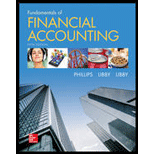
Concept explainers
Analyzing the Effects of Transactions Using T-Accounts, Preparing an Unadjusted
Spicewood Stables, Inc. was established in Dripping Springs, Texas, on April 1. The company provides stables, care for animals, and grounds for riding and showing horses. You have been hired as the new assistant controller. The following transactions for April are provided for your review.
- 1. Received contributions from investors and issued $200,000 of common stock on April 1.
- 2. Built a barn and other buildings for $142,000. On April 2, the company paid half the amount in cash and signed a three-year note payable for the balance.
- 3. Provided $16,000 in animal care services for customers on April 3, all on credit.
- 4. Rented stables to customers who cared for their own animals; received cash of $13,000 on April 4 for rent earned this month.
- 5. On April 5, received $1,500 cash from a customer to board her horse in May, June, and July (record as Unearned Revenue).
- 6. Purchased hay and feed supplies on account on April 6 for $3,000.
- 7. Paid $1,700 on accounts payable on April 7 for previous purchases.
- 8. Received $1,000 from customers on April 8 on
accounts receivable . - 9. On April 9, prepaid a two-year insurance policy for $3,600 for coverage starting in May.
- 10. On April 28, paid $800 in cash for water and utilities used this month.
- 11. Paid $14,000 in wages on April 29 for work done this month.
- 12. Received an electric utility bill on April 30 for $1,200 for usage in April; the bill will be paid next month.
Required:
- 1. Record the effects of transactions (1) through (12) using
journal entries . - 2. If you are completing this requirement manually, set up appropriate T-accounts. All accounts begin with zero balances. Summarize the journal entries from requirement 1 in the T-accounts, referencing each transaction in the accounts with the transaction number. Show the unadjusted ending balances in the T-accounts. If you are using the GL tool in Connect, your answers to requirement 1 will have been posted automatically to general ledger accounts that are similar in appearance to Exhibit 2.9.
- 3. Prepare an unadjusted trial balance as of April 30. If you are using the GL tool in Connect, this requirement is completed automatically using your previous answers.
- 4. Refer to the revenues and expenses shown on the unadjusted trial balance. Based on this information, calculate preliminary net income and determine whether the net profit margin is better or worse than the 30.0 percent earned by a close competitor.
1.
To prepare: The journal entries for each transaction.
Explanation of Solution
Journal:
Journal is the book of original entry. Journal consists of the day today financial transactions in a chronological order. The journal has two aspects; they are debit aspect and the credit aspect.
Accounting Equation:
The accounting equation implies the relationship between the assets, liabilities, and the stockholders equity. The balance of both the assets and the liabilities, stockholders equity must be equally balanced. The accounting equation is as follows;
- 1. Journalize the issuance of common stock.
| Date | Account Title and Explanation | Debit ($) | Credit ($) |
| April, 1 | Cash (A+) | 200,000 | |
| Common stock (SE+) | 200,000 | ||
| (To record the issuance of common stock to investors) |
Table (1)
- Cash is an asset account. Thus, an increase in cash increases the asset account. Hence, debit cash account by $200,000.
- Common stock is a component of stockholder equity account. Thus, an increase in common stock increases the stockholders equity account. Hence, common stock account is being credited to increase its balance by $200,000.
- 2. Journalize the purchase of building partly on cash and partly on account by signing a note.
| Date | Account Title and Explanation | Debit ($) | Credit ($) |
| April, 2 | Buildings (A+) | 142,000 | |
| Notes payable (L+) | 71,000 | ||
| Cash (A–) | 71,000 | ||
| (To record the purchase of building partly for cash and partly by signing a note ) |
Table (2)
- A building is an asset account. Thus, an increase in buildings account increases the asset account. Hence, debit buildings account by $142,000.
- Notes payable is a liability account. Thus, an increase in notes payable increases the liability account. Hence, notes payable account is being credited to increase its balance by $71,000.
- Cash is an asset account. Thus, a decrease in cash decreases the asset account. Hence, credit cash account by $71,000.
- 3. Journalize the service provided on account.
| Date | Account Title and Explanation | Debit ($) | Credit ($) |
| April, 3 | Accounts receivable (A+) | 16,000 | |
| Service revenue (R+, SE+) | 16,000 | ||
| (To record the service made on account ) |
Table (3)
- Accounts receivable is an asset account. Thus, an increase in accounts receivable increases the asset account. Hence, debit accounts receivable account by $16,000.
- Service revenue is a stockholder’s equity account. Thus, an increase in service revenue increases the stockholder’s equity account. Hence, service revenue account is being credited to increase its balance by $16,000.
- 4. Journalize the rent earned.
| Date | Account Title and Explanation | Debit ($) | Credit ($) |
| April, 4 | Cash (A+) | 13,000 | |
| Rent revenue (R+, SE+) | 13,000 | ||
| (To record the rent earned) |
Table (4)
- Cash is an asset account. Thus, an increase in cash increases the asset account. Hence, debit cash account by $13,000.
- Rent revenue is a stockholder’s equity account. Thus, an increase in rent revenue increases the stockholder’s equity account. Hence, rent revenue account is being credited to increase its balance by $13,000.
- 5. Journalize the cash received from customer for the service yet to provide.
| Date | Account Title and Explanation | Debit ($) | Credit ($) |
| April, 5 | Cash (A+) | 1,500 | |
| Unearned revenue (L+) | 1,500 | ||
| (To record the unearned revenue) |
Table (5)
- Cash is an asset account. Thus, an increase in cash increases the asset account. Hence, debit cash account by $1,500.
- Unearned revenue is a liability account. Thus, an increase in unearned revenue increases the liability account. Hence, unearned revenue account is being credited to increase its balance by $1,500.
- 6. Journalize the purchase of supplies on account.
| Date | Account Title and Explanation | Debit ($) | Credit ($) |
| April, 6 | Supplies (A+) | 3,000 | |
| Accounts payable (L+) | 3,000 | ||
| (To record the purchase of supplies on account) |
Table (6)
- A supply is an asset account. Thus, an increase in supplies increases the asset account. Hence, debit supplies account by $3,000.
- Accounts payable is a liability account. Thus, an increase in accounts payable increases the liability account. Hence, accounts payable account is being credited to increase its balance by $3,000.
- 7. Journalize the amount paid for the purchase made already.
| Date | Account Title and Explanation | Debit ($) | Credit ($) |
| April, 7 | Accounts payable (L–) | 1,700 | |
| Cash (A–) | 1,700 | ||
| (To record the amount paid for the purchases made already) |
Table (7)
- Accounts payable is a liability account. Thus, an increase in accounts payable increases the liability account. Hence, accounts payable account is being credited to increase its balance by $1,700.
- Cash is an asset account. Thus, a decrease in cash decreases the asset account. Hence, credit cash account by $1,700.
- 8. Journalize the amount received from customer.
| Date | Account Title and Explanation | Debit ($) | Credit ($) |
| April, 8 | Cash (A+) | 1,000 | |
| Accounts receivable (A–) | 1,000 | ||
| (To record the cash receipt for the service performed on account ) |
Table (8)
- Cash is an asset account. Thus, an increase in cash increases the asset account. Hence, debit cash account by $1,000.
- Accounts receivable is an asset account. Thus, a decrease in accounts receivable decreases the asset account. Hence, credit accounts receivable account by $1,000.
- 9. Journalize the prepaid insurance.
| Date | Account Title and Explanation | Debit ($) | Credit ($) |
| April, 9 | Prepaid insurance (A+) | 3,600 | |
| Cash (A–) | 3,600 | ||
| (To record the prepaid insurance) |
Table (9)
- Prepaid insurance is an asset account. Thus, an increase in prepaid insurance increases the asset account. Hence, debit prepaid insurance account by $3,600.
- Cash is an asset account. Thus, a decrease in cash decreases the asset account. Hence, credit cash account by $3,600.
- 10. Journalize the utilities expense.
| Date | Account Title and Explanation | Debit ($) | Credit ($) |
| April, 28 | Utilities expenses (E+, SE-) | 800 | |
| Cash (A-) | 800 | ||
| (To record the utilities expenses ) |
Table (10)
- Utilities expense is an expense account which comes under Retained earnings in stockholder’s equity. Thus, an increase in utilities expense account decreases the stockholder’s equity account. Hence, utilities expenses account is being debited to increase its balance by $800.
- Cash is an asset account. Thus, a decrease in cash account decreases the asset account. Hence, cash account is being credited to decrease its balance by $800.
- 11. Journalize the payment made for the wages.
| Date | Account Title and Explanation | Debit ($) | Credit ($) |
| April, 29 | Salaries and Wages Expense (E+, SE–) | 14,000 | |
| Cash (A-) | 14,000 | ||
| (To record the payment made for the repair charges) |
Table (11)
- Salaries and wages expense is an expense account which comes under Retained earnings in stockholder’s equity. Thus, an increase in salaries and wages expense account decreases the stockholder’s equity account. Hence, salaries and wages expense account is being debited to increase its balance by $14,000.
- Cash is an asset account. Thus, a decrease in cash account decreases the asset account. Hence, cash account is being credited to decrease its balance by $14,000.
- 12. Journalize the bill received for utility expenses incurred, and it will be paid later.
| Date | Account Title and Explanation | Debit ($) | Credit ($) |
| April, 30 | Utilities expenses (E+, SE-) | 1,200 | |
| Accounts payable (L+) | 1,200 | ||
| (To record the bill received for the utilities expenses incurred) |
Table (12)
- Utilities expense is an expense account which comes under Retained earnings in stockholder’s equity. Thus, an increase in utilities expense account decreases the stockholder’s equity account. Hence, utilities expenses account is being debited to increase its balance by $1,200.
- Accounts payable is a liability account. Thus, an increase in accounts payable increases the liability account. Hence, accounts payable account is being credited to increase its balance by $1,200.
2.
To show: The unadjusted ending balances in T-accounts.
Explanation of Solution
T-account:
An account is referred to as a T-account, because the alignment of the components of the account resembles the capital letter ‘T’. An account consists of the three main components which are as follows:
- The title of the account
- The left or debit side
- The right or credit side
The posting of the journal entries to the T accounts are as follows:
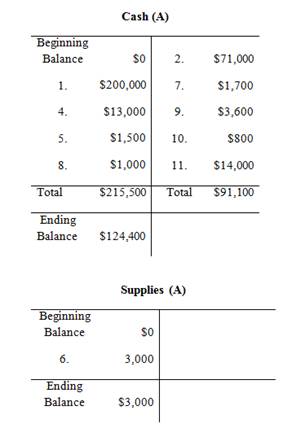
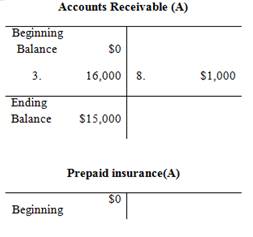
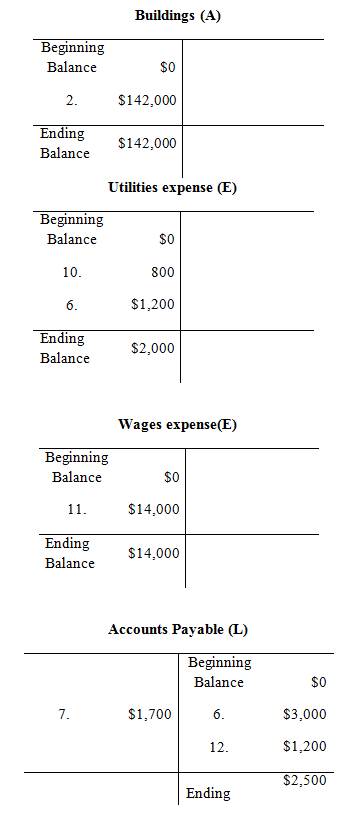
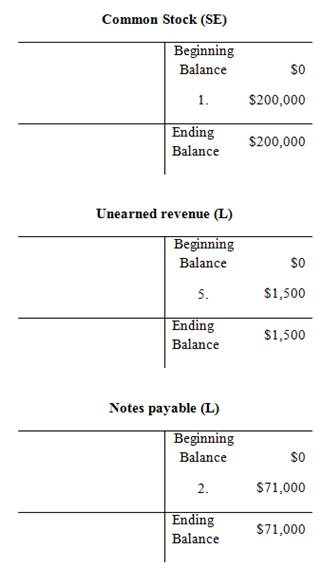

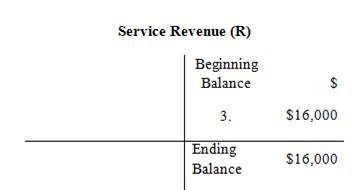
3.
To prepare: The unadjusted Trial balance at the end of April.
Explanation of Solution
Unadjusted trial balance:
Unadjusted trial balance is that statement which contains complete list of accounts with their unadjusted balances. This statement is prepared at the end of every financial period.
The unadjusted Trial balance of Incorporation Sat the end of April is prepared as follows:
| Incorporation S | ||
| Unadjusted Trial Balance | ||
| At April 30 | ||
| Particulars | Debit | Credit |
| Cash | $124,400 | |
| Accounts Receivable | 15,000 | |
| Supplies | 3,000 | |
| Prepaid Insurance | 3,600 | |
| Buildings | 142,000 | |
| Accounts Payable | $2,500 | |
| Unearned Revenue | 1,500 | |
| Notes Payable | 71,000 | |
| Common Stock | 200,000 | |
| Service Revenue | 16,000 | |
| Rent Revenue | 13,000 | |
| Utilities Expense | 2,000 | |
| Salaries and Wages Expense | 14,000 | |
| Total | $304,000 | $304,000 |
Table (13)
The debit column and credit column of the unadjusted trial balance are agreed, both having balance of $304,000.
4.
To calculate: The preliminary net income and net profit margin and determine whether the net profit is better or worse than the competitor.
Explanation of Solution
Net income: Net income is the excess amount of revenue which arises after deducting all the expenses of a company. In simple terms, it is the difference between total revenue and total expenses of the company.
The preliminary net income of the company is determined as follows:
| Particulars | Amount ($) | Amount ($) |
| Revenues: | ||
| Service Revenue | $16,000 | |
| Rent Revenue | 13,000 | |
| Total Revenues | 29,000 | |
| Less: Expenses: | ||
| Utilities Expense | 2,000 | |
| Salaries and Wages Expense | 14,000 | |
| Total Expenses | 16,000 | |
| Net Income | $13,000 |
Table (8)
The net profit margin of the Company is determined as follows:
Incorporation S is performing better than its competitor with a net profit margin of 44.8%.
Want to see more full solutions like this?
Chapter 3 Solutions
Fundamentals of Financial Accounting
 Financial AccountingAccountingISBN:9781337272124Author:Carl Warren, James M. Reeve, Jonathan DuchacPublisher:Cengage Learning
Financial AccountingAccountingISBN:9781337272124Author:Carl Warren, James M. Reeve, Jonathan DuchacPublisher:Cengage Learning Financial AccountingAccountingISBN:9781305088436Author:Carl Warren, Jim Reeve, Jonathan DuchacPublisher:Cengage Learning
Financial AccountingAccountingISBN:9781305088436Author:Carl Warren, Jim Reeve, Jonathan DuchacPublisher:Cengage Learning Financial Accounting: The Impact on Decision Make...AccountingISBN:9781305654174Author:Gary A. Porter, Curtis L. NortonPublisher:Cengage Learning
Financial Accounting: The Impact on Decision Make...AccountingISBN:9781305654174Author:Gary A. Porter, Curtis L. NortonPublisher:Cengage Learning- Principles of Accounting Volume 1AccountingISBN:9781947172685Author:OpenStaxPublisher:OpenStax CollegeCentury 21 Accounting Multicolumn JournalAccountingISBN:9781337679503Author:GilbertsonPublisher:Cengage
 Excel Applications for Accounting PrinciplesAccountingISBN:9781111581565Author:Gaylord N. SmithPublisher:Cengage Learning
Excel Applications for Accounting PrinciplesAccountingISBN:9781111581565Author:Gaylord N. SmithPublisher:Cengage Learning





